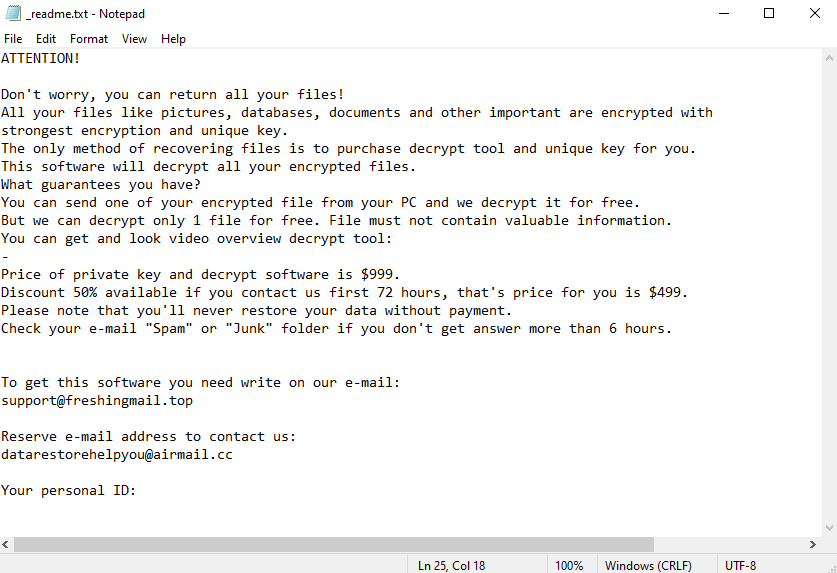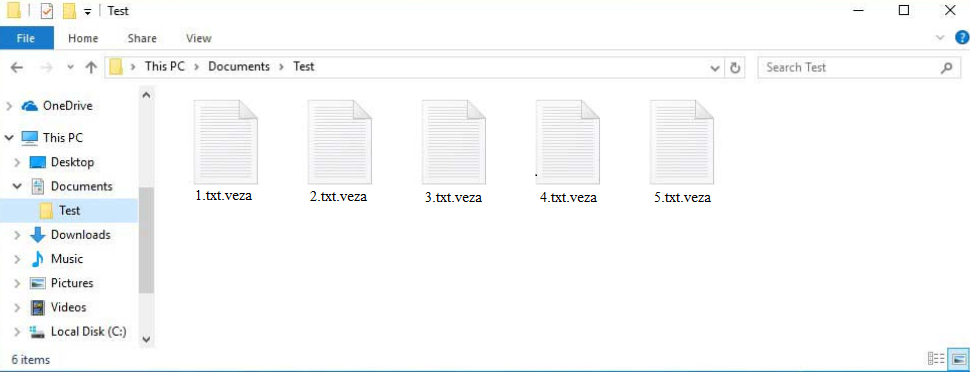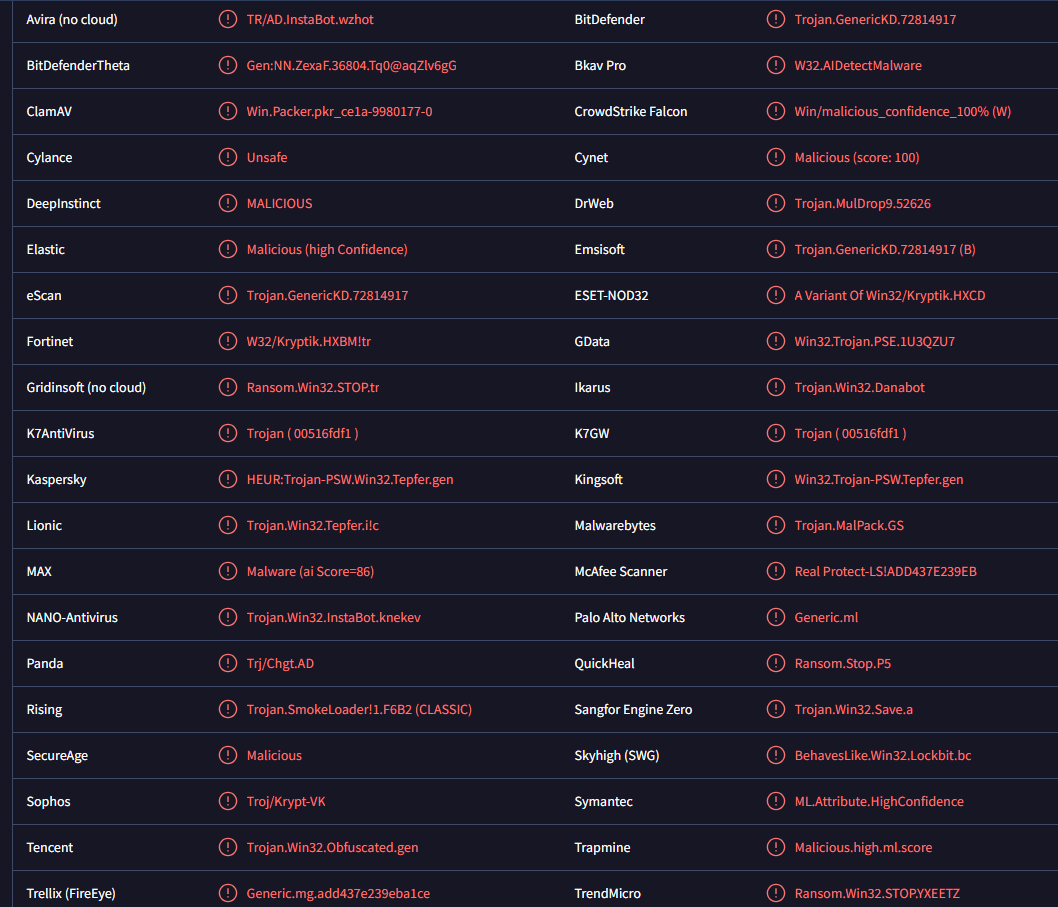Delete Veza ransomware
Veza ransomware is file-encrypting malware that takes files hostage and demands payment for their recovery. It’s part of the Djvu/STOP ransomware family and is considered to be a very dangerous infection because file recovery is not always possible. Only users who have a backup can recover files for free at the moment.
If you suddenly find that you cannot open your files and file names have .veza added to them, your computer is infected with Veza ransomware. The ransomware targets all personal files, including photos, videos, documents, images, etc. An encrypted file always has an extension, in this case .veza. For example, 1.txt would appear as 1.txt.veza if encrypted. These files are targeted because they are the ones users are most willing to pay for to get back. Once encrypted, you will not be able to open them until you run them through a special decryptor.
When ransomware is done encrypting files, it will drop a _readme.txt ransom note. The note explains what ransomware victims have to do to get the decryptor necessary for file recovery. According to the note, the decryptor costs $999 but there’s a 50% discount for users who contact the malware operators within 72 hours of file encryption. The cybercriminals also promise to decrypt one file free if it does not contain important information.
Paying the ransom is never recommended because it does not guarantee a decryptor. Victims should keep in mind that they are dealing with cyber criminals who do not care whether users get their files back. Even if victims pay, there’s nothing that would force the cybercriminals to send the decryptor. Many victims have paid in the past but failed to receive a decryptor. This, unfortunately, happens more often than users may think.
Whether you pay or not is your decision but you need to be aware of the risks that come with giving in to the demands. It should also be mentioned that the money users pay funds future criminal activities. As long as users continue to pay, ransomware will thrive.
ATTENTION!
Don’t worry, you can return all your files!
All your files like pictures, databases, documents and other important are encrypted with strongest encryption and unique key.
The only method of recovering files is to purchase decrypt tool and unique key for you.
This software will decrypt all your encrypted files.
What guarantees you have?
You can send one of your encrypted file from your PC and we decrypt it for free.
But we can decrypt only 1 file for free. File must not contain valuable information.
Do not ask assistants from youtube and recovery data sites for help in recovering your data.
They can use your free decryption quota and scam you.
Our contact is emails in this text document only.
You can get and look video overview decrypt tool:
–
Price of private key and decrypt software is $999.
Discount 50% available if you contact us first 72 hours, that’s price for you is $499.
Please note that you’ll never restore your data without payment.
Check your e-mail “Spam” or “Junk” folder if you don’t get answer more than 6 hours.To get this software you need write on our e-mail:
support@freshingmail.topReserve e-mail address to contact us:
datarestorehelpyou@airmail.ccYour personal ID:
If users have backups, they can start file recovery as soon as they remove Veza ransomware from their computers. It’s strongly recommended to use an anti-malware program for Veza ransomware removal because it’s a complex infection. If users try to delete Veza ransomware manually, they could end up causing additional damage to their computers.
In case users do not have a backup, they should back up the encrypted files and wait for a free Veza ransomware decryptor to be released. Djvu/STOP ransomware versions are difficult to crack so a free decryptor is not guaranteed. If it does get released, it will be downloadable from NoMoreRansom. It’s a great source for decryptors, and if a decryptor is not available there, it likely won’t be available anywhere else.
How is ransomware distributed?
Veza ransomware is distributed through the usual methods, including email attachments, torrents, malicious links/ads, etc. Users with bad browsing habits are much more likely to pick up an infection than those who browse safely. Developing better online habits and becoming familiar with common malware distribution methods are effective ways to avoid malware infections.
Malicious actors often spread malware using email attachments. They attach malicious files to emails that are made to look like parcel delivery notifications, order confirmations, etc. How convincing the emails look depends on how sophisticated the malicious campaign is. It’s also common for malicious emails to claim that the attached files are important documents that need to be reviewed. Malicious actors pressure users into making rash decisions by creating a sense of urgency. Fortunately, malicious emails are often easy to recognize. One of the biggest giveaways is grammar and spelling mistakes. Mistakes are very rare in legitimate emails, especially automatic ones.
How an email addresses users can also tell a lot about whether it’s legitimate. Malicious/spam emails tend to use generic words like User, Member, Customer, etc., to address users because malicious campaigns target many users with the same email. Malicious actors also rarely have access to personal information like names. Legitimate emails, especially parcel delivery notifications/order confirmations, use users’ names to address them.
When malicious actors target a specific person, malicious emails are significantly more sophisticated. Such emails are written professionally and contain information that makes them seem more credible. Such sophisticated emails are why it’s important to scan all unsolicited email attachments with anti-virus software or VirusTotal before opening them.
It’s also easy to pick up ransomware via torrents. Torrent sites are often poorly regulated and full of malware. Torrents for popular entertainment content (movies, TV series, video games) are particularly likely to have malware in them. Torrenting copyrighted content is not only content theft, it’s also dangerous for the computer.
How to remove Veza ransomware
As mentioned already, ransomware is a complex infection that requires a professional anti-malware program. Users should not attempt to delete Veza ransomware manually because it could cause further damage. Once anti-malware software no longer detects the ransomware, users can safely connect to their backups and start recovering files. If a backup is not available, users should back up the encrypted files and wait for a free Veza ransomware decryptor to be released.
Veza ransomware is also detected as:
- Trojan.GenericKD.72814917 by BitDefender
- HEUR:Trojan-PSW.Win32.Tepfer.gen by Kaspersky
- A Variant Of Win32/Kryptik.HXCD by ESET
- Trojan.MalPack.GS by Malwarebytes
- Ransom.Win32.STOP.YXEETZ by TrendMicro
- Trojan.GenericKD.72814917 (B) by Emsisoft
Site Disclaimer
WiperSoft.com is not sponsored, affiliated, linked to or owned by malware developers or distributors that are referred to in this article. The article does NOT endorse or promote malicious programs. The intention behind it is to present useful information that will help users to detect and eliminate malware from their computer by using WiperSoft and/or the manual removal guide.
The article should only be used for educational purposes. If you follow the instructions provided in the article, you agree to be bound by this disclaimer. We do not guarantee that the article will aid you in completely removing the malware from your PC. Malicious programs are constantly developing, which is why it is not always easy or possible to clean the computer by using only the manual removal guide.



